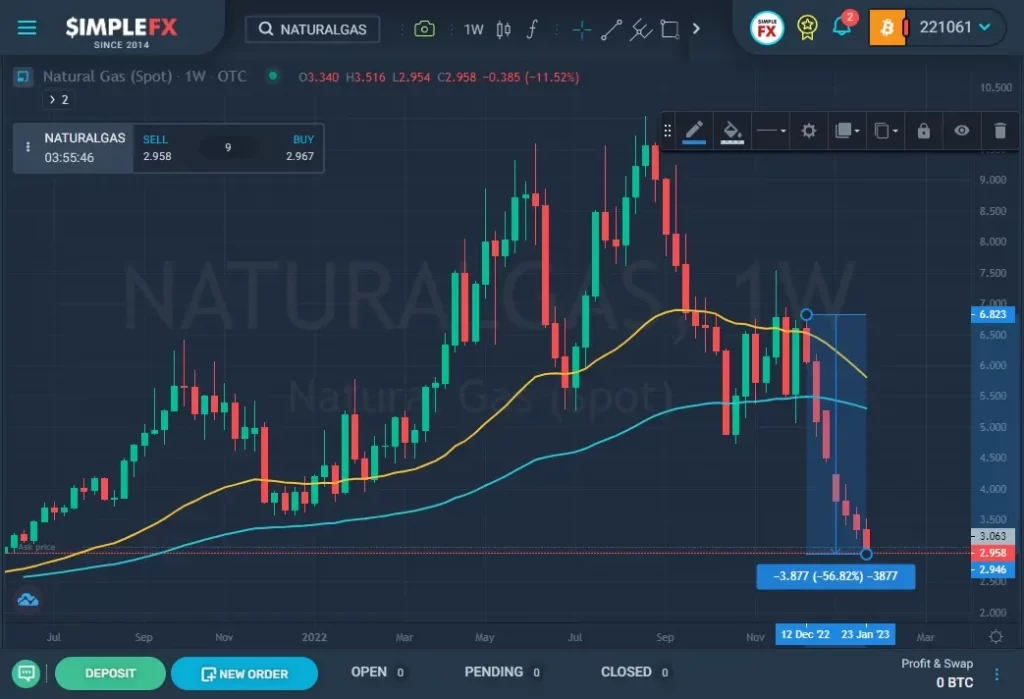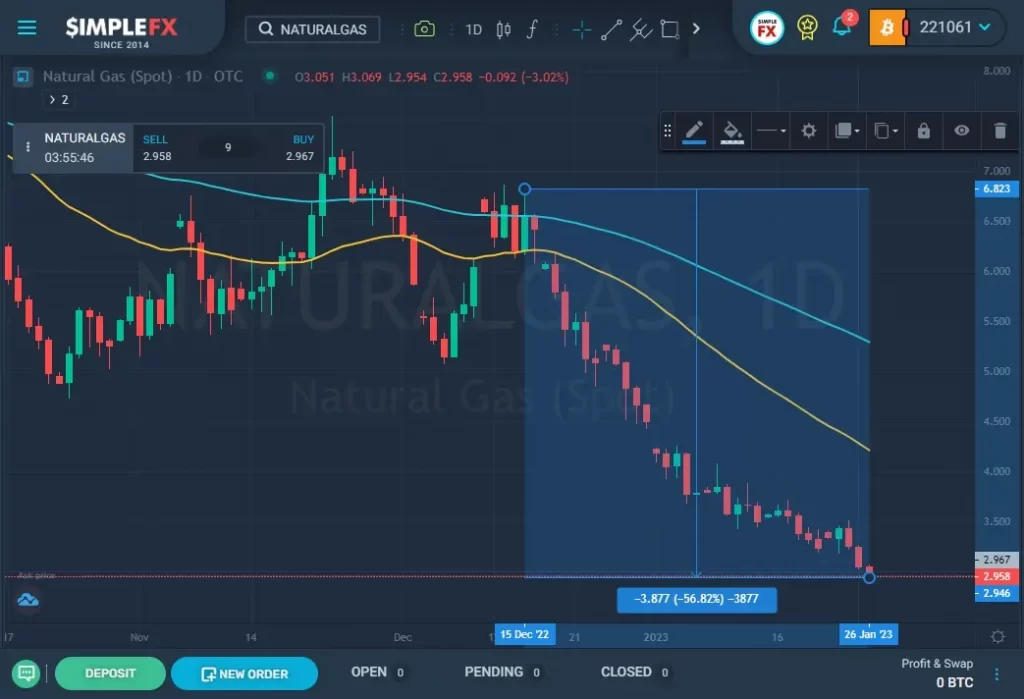Last month’s natural gas price plunge was sudden and unexpected, leaving many investors and traders reeling. The market saw a dramatic collapse throughout the year, driven by a hot winter in Europe, the increased use of renewable alternatives, and sanctions on Russia. These events have profoundly affected the natural gas market. Analysts are still trying to figure out what to expect next. This article will explore the four main reasons for the 2023 natural gas price plunge. I will also try to figure out what to expect in the future.
Table of contents:
2023 Natural Gas Price Plunge
Natural gas spot prices saw a dramatic collapse in 2023. The trend started in August, when the commodity peaked in response to war and sanctions on Russia, the world’s largest exporter of natural gas. A hot winter in Europe and the increased use of renewable alternatives such as solar and wind power have driven down prices.
However, the situation may change if temperatures drop this winter and the demand for natural gas increases. This article will explore the factors behind the 2023 natural gas price plunge and what to expect in the future.
1. 2023 Natural Gas Price Plunge Since August
The natural gas market has been in turmoil over the past year, with spot prices fluctuating wildly. In August 2022, prices soared to an all-time high of $10.034 per MMBtu. It was because investors feared an impending energy crisis caused by sanctions on Russia following its invasion of Ukraine. The market was sent into a frenzy as traders scrambled to secure supplies. Moreover, many panicked investors rushed to sell their positions.
However, it soon became apparent that Western economies could find alternatives to Russian natural gas. So the crisis failed to materialize. As a result, demand for natural gas dropped dramatically, and prices tumbled to $4.74 in October 2022. This sudden and unexpected shift in the market sent shockwaves through the industry, and many traders were left holding significant losses.
Read also: Natural Gas Continues to Fall Despite the Leaks in Nord Streams 1 and 2?
Investors Take Advantage of the Unpredictable Natural Gas Market
When the market stabilized, prices suddenly rebounded in November 2022, climbing back to $7.545. This sudden resurgence caught many investors off guard, and many rushed to buy back into the market, hoping to capitalize on the rally.
Prices crashed again to just over $3 per MMBtu in January 2023. The market remains highly unpredictable, with analysts speculating that prices could fluctuate in the coming months. The natural gas industry is in flux, and it’s still being determined where prices will go from here. But one thing is for sure, the rollercoaster ride for natural gas prices is far from over.

2. Renewable Substitutes Looming
The US Energy Information Administration (EIA) expects that combined wind and solar generation will overtake traditional fossil fuels such as natural gas and coal-fired generation in the United States this year, heralding a groundbreaking development. This is a major shift in the country’s energy landscape and marks a significant step towards a cleaner and more sustainable future.
The increased use of renewable energy is not only good news for the environment. Still, it is also expected to bring about a decline in natural gas prices. As more and more households and businesses turn to solar and wind energy, the demand for natural gas is likely to decrease, resulting in lower prices for consumers. This is also expected to have a knock-on effect on coal generation, which may decline as it becomes less economically viable.
Sanctions Impact EU’s Natural Gas Supplies from Russia
In 2018, combined wind and solar generated about 8% of total generation in the US. This trend will likely continue as the US aims to reduce carbon emissions by 80% by 2050. This is a significant increase and demonstrates the country’s growing importance of renewable energy.
The EU’s reduction in natural gas exports from Russia resulted from the sanctions imposed due to Russia’s actions in Ukraine. This has made the EU more dependent on its resources, including renewable energy sources, to meet its energy needs.
3. A Double Shoulder Pattern Is More Apparent
The natural gas market has been hit with a dramatic price drop over the past month, leaving investors and traders alike reeling. Spot prices have fallen by a staggering 53% since December 2023 and 13.32% between Monday, January 24, and Wednesday, January 26. This marks the longest losing streak for the commodity since the middle of September.
From a technical analysis standpoint, the situation looks dire. There has been a notable confirmatory downside breakout under December 2021 low at 3.536, opening the door to a resumption of the dominant downtrend that began in August 2022. Many experts are concerned that prices could continue to fall, potentially reaching the 2020 low of 1.44.
Furthermore, prices continue to trade downward with a bearish Head and Shoulders chart formation. This formation, when completed, can indicate a bearish reversal of the trend, and the estimated trajectory of this formation may take prices down to the 1.44 – 1.61 support zone. This is a cause for concern for many traders and investors closely monitoring the situation.

Inverted Hammer Pattern Leaves Traders Uncertain
Many traders and investors closely watch the daily chart for signs of where prices may be headed, as the sharp price decline of the natural gas market has been hit. Prices have confirmed a breach below $3.5536 daily, pushing natural gas closer to the inflection point of $3.15 in May 2021.
However, prices could not close under the latter last week, reinforcing it as immediate support. This is important to watch, as a close below could signal further downside. A candlestick pattern of an Inverted Hammer was also left behind, indicating not necessarily an early reversal. Still, it would be worth paying attention to see if prices bounce in the coming sessions. As a result, the 20-day Simple Moving Average (SMA), which may serve as significant resistance and keep the downside in focus, would come into focus.
If not, a breakdown below 3.15 would reveal the 100% Fibonacci extension level at 2.326, which points toward the 2020 low.
4. Demand and Weather
Demand, influenced by weather conditions in the northern hemisphere during winter, affects natural gas prices.
A surprisingly warm winter in Europe helped push gas prices lower. Still, the bitter cold in China is now pushing them even higher. Over the weekend, numerous weather stations in northernmost China’s Heilongjiang Province reached the lowest temperatures they had ever recorded. Mohe City, the northernmost city in China, reached lows for three straight days below minus 50 degrees Celsius. China’s meteorology agency has issued nationwide warnings of freezing weather this week.
Last summer, Russia’s halt in natural gas exports to Europe had a ripple effect on the global market. China is now feeling the impact. Much of the Russian gas imported by China was at very high prices. It has added to the country’s energy regulations and infrastructure strain.
Stay Informed: Natural Gas Prices Can Change at Any Moment
As the winter weather continues to grip China and other parts of the northern hemisphere, the demand for natural gas remains high. The increased demand has caused prices to rise, but we have yet to determine the future for the 2023 natural gas price plunge.
The global market remains unpredictable, and events such as Russia’s invasion of Ukraine and the ongoing crisis in China continue to affect the natural gas industry. Experts closely monitor the situation and advise consumers to stay informed about any changes in the market.
The future of natural gas prices remains uncertain. Nevertheless, one thing is for sure – the world needs to prepare for the unexpected.

